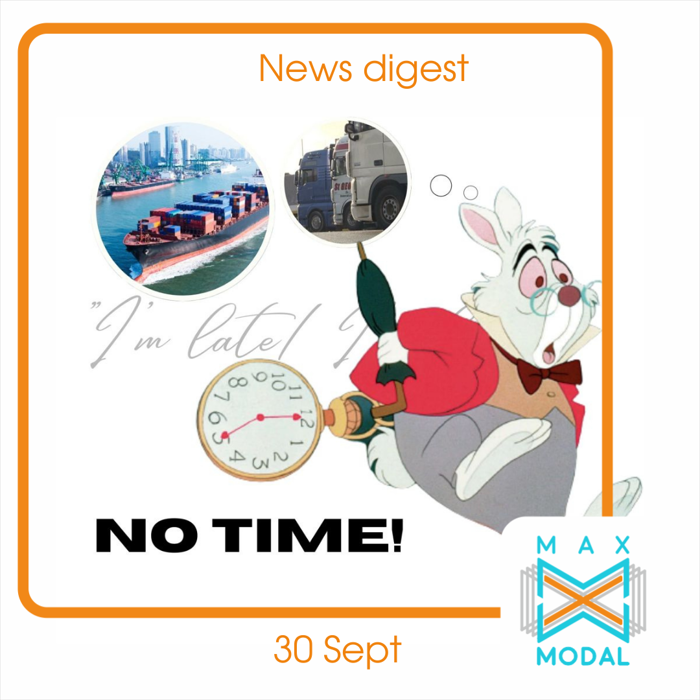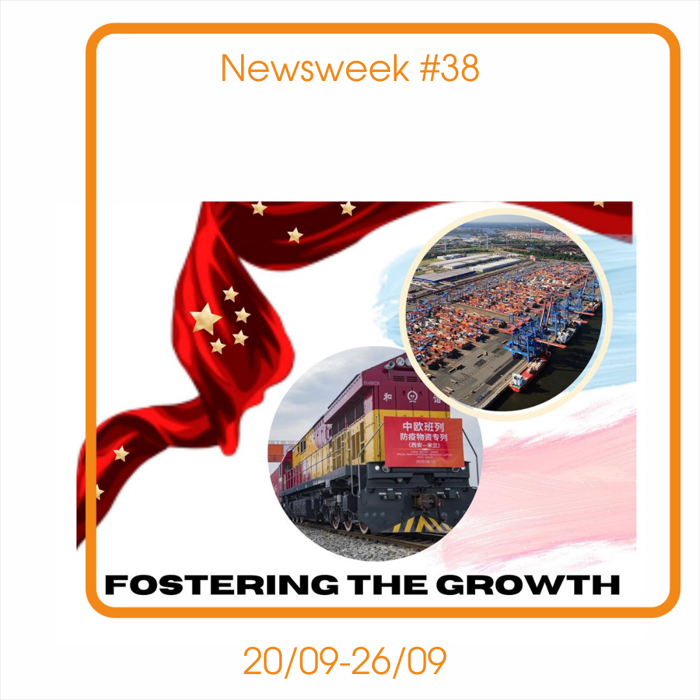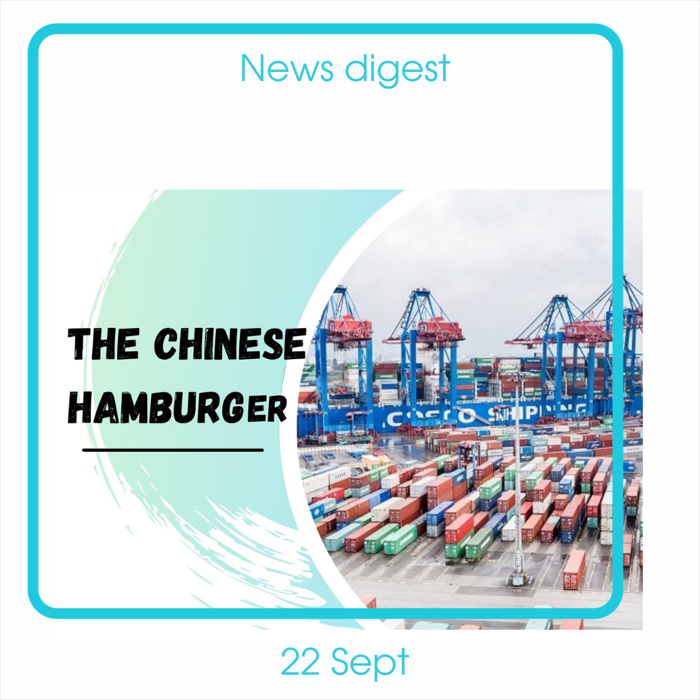Let’s talk numbers: the post-crisis aftermath in ruined schedules and omitted ports. Deliveries are late everywhere, but what becomes the last drop is a soaring inflation.
With everything at six and seven, meaning a complete disaster on the market, it is no wonder that schedule reliability is gone waving with a handkerchief from the platform. Across more than thirty trade lanes and numerous carriers, it has dropped to the all-time low 33.6% in August, and although Maersk has proven to be the most reliable one, it still has not been able to escape reschedules and omissions of the most congested ports. This had led to many shippers delivering their goods later than ever – if we look at the days taken, the number is 83% higher than in September 2019. As a result, major inflation has spanned, particularly in the US. Growing rates have all chances to make the upcoming contracting season the toughest in ocean freight history for shippers that already can no longer absorb the costs. They have tried to shift to airfreight but the increase rate paired with the soaring demand and tight capacity repulsed them, and the marine sector is risking repeating the same dynamic. The interconnection with China is not contributing even to the slightest improvement. On the contrary, a marginal increase in container throughput has put the Chinese sector in a highly disadvantageous position that throws shade in the direction of North America as well. From January to August 2021, the number reached 186.7 million TEU, increasing 11.1% from the same period in 2020. The extra vessels that ports had to handle have also contributed to the worsening of the bottlenecks problem. In the US, The Georgia Port Authority has invested $34 mil into the Port of Savannah to help expedite an additional 1.6 million TEU in capacity. Malaysian ports are in the same boat. The lockdown pressure and inland disruptions had a big impact on the container sector, thus the authorities plan to invest in the construction of more resilient ports. Things are getting more intense as Hapag-Lloyd is investing in the JadeWeserPort in Wilhelmshaven, following the decision of its competitor Cosco to acquire a stake in a container port in Hamburg.
Companies are desperately trying to introduce new services that could somehow ease the problem of the tight capacity. The recent one is the result of the cooperation of several players that will connect Korea and Central/South China to Southeast Asia from the Port of Pusan. In turn, China sees a promising partnership of Taiwanese carrier TS Lines and New Zeeland that has resulted in the launch of a new liner. In fact, more and more experts call for a collaborative approach that seems to be one of the few strategies that work against the current challenges. It does not solely concern the expansion of assets or the deployment of new vessels altogether, this approach also regards the steps towards sustainable development. While trying to save economic capacity, charterers are coming under pressure to optimize their supply chain and contracts to minimize emissions. Many admit that green initiatives will be a financial burden, although they are necessary for the safety of the planet. Maersk shoots for the stars and picks one of the biggest players – China – to be its partner. The new agreements signed with the China Classification Society aim to proceed with its decarbonization strategy. The shipping giant wants to be first on all frontiers and takes the reigns of developing the right set of standards, rules, and technical solutions for everyone to play accordingly.
The rail locomotive is also on the way to the brighter and greener future under the new “Rail Freight, The Future is Ours” initiative with the active participation of the Port of Rotterdam. The goal is to gather all the ambassadors from across the sector to help in transporting 50% more freight on the Dutch railway network within the next ten years. However, not everything is so blue and sunny above European railways. The focus risks switching to Spain where the potential strike can disrupt the container moves. While there is still uncertainty whether it will take place or not Maersk has already taken precautions and announced that it was looking for alternative options and warned about delays.
For sustainable development, it is also crucial to consider the future of LNG because there have been doubts regarding it as several LNG-fuelled orders were canceled after a complaint against a backcloth of soaring gas prices. The plans to reduce carbon emissions are very ambitious but for the most part, they omit such an ossified and snail-paced sector as LNG-fuelled vessels. However, some companies state that the questionable ships are designed as dual-fuelled and could be run on low-sulphur fuel oil.
As for the drivers’ shortages in the UK where things have finally taken a more positive turn, companies are willing to tackle the problem of underqualified workers. Training programs are on the way out and it is something that companies are really planning to invest in, taking into account the benefits in the long run.

Power curbs in China suddenly disrupt the already sensitive shipping sector. Although Christmas is upon us, this is not the right stimulus to light up candles.
There already has been a lot on the plate in every sector but now, as winter approaches, gas prices are skyrocketing and the new wave of protests against high electricity bills washes over Europe, companies brace up for the consequences for shipping. Due to the recent power curbs in Chinese provinces, very soon the global markets will feel the pinch of a shortage of supply almost everywhere even more. As a result, many factories are planning to further delay deliveries of U.S. imports. Major clothing companies continuously report inventory increases and now the shutdowns of the factories created a gap to the flow of inventory. A lot of goods are at risk of not being delivered on time, therefore, Costco, has become the latest American brand to take shipping matters into its own hands and chattered three vessels. As there is no relief in sight and everyone promises things to get more tight, the Port of LA authorities are asking the federal government to reconsider the priorities in terms of port investment areas to help alleviate supply chain crunches hitting the nation’s retailers. In fact, the recent day shave been eventful in terms of different requests targeting the official from the US shippers. Another one concerns the pleas to reject the proposed Ocean Shipping Reform Act of 2021because of the unfair demurrage and detention charges applied in case the containers are not picked up within the agreed-upon timeframe. The agreement is almost impossible to follow with all the schedule disruptions.
Sensing where the wind is blowing, big players try to be ahead of the curve and announce the redaction in the number of port calls in an attempt to speed up schedules. They also advise to book slots in advance as Christmas approaches and warn that inventory levels are still at the lowest while demand keeps growing. In particular, Maersk has projectedthat global container demand growth from 6% to 8% in 2021.
The current year has granted not only the record increase in congestion and the crashing aftermaths of it but It has also broken through all S&P records despite the fact that 2021 is not over yet. Containership and bulker S&P prices are up by around 120% and 70% respectively since the start of the year. Analytics report that the industry is on track for 7.3% of the start year fleet to change hands this year, the highest since 2007.
While omitting ports can be one of the ways to deal with the increasing pressure, there is another one involving barges turned into floating storage platforms at the Port of Rotterdam. Initially, they were called in to fill their vessels with some number of TEUs of empties and find a way of connecting these to ocean carriers for evacuation from more congested Rotterdam to less crowded Antwerp, but long delays at terminals have pushed barge owners to find other ways of solving the problem. Everyone survives as best he can? Others hope for the government measures, thus in India the authorities decide to tackle the problem of container shortage by extending the deadline for the re-export of imported vessels lying at different domestic ports. To put it simply, less export of empty containers from the country will increase the availability of containers for trade. This comes at the same time with the shipping lines having repositioned 1.7 million empty TEU into India, at a huge cost. In addition, the CSLA member lines have placed orders for 500 new vessels. The fleet expansion seems to be one of the few strategies that might work against capacity shortage as not only Indian companies use it to their advantage. The Canadian vessel owner and operator, Seaspan Corporation has followed suit and entered into an agreement for ten 7,000 TEU scrubber-fitted new container ships. Meanwhile, another big acquisition has taken place with China International Marine Containers Ltd. taking over Maersk owned Container Industry reefer manufacturer. At the same time, the rail industry has experienced a similar move by Hapag-Lloyd.
It seems like the ice has cracked in the issue of drivers’ shortages in the UK. The government will suspend the competition law for the fuel industry to allow fuel companies to more easily share information and priorities areas of the country most in need of deliveries to petrol stations. In addition, a major breakthrough has been achieved – a new package of measures will grant visas to drivers, which has been the stumbling stone in recent weeks.
Experts continue to debate about the best approach in transition to an emission-free world. The areas of discussion include the sources of financing, the role of digitalization, etc. There is a high chance that terminals in countries with poor electrical grid networks may need to self-generate energy in the future. Each point is an ecosystem on its own, thus it will need individual efficiency that can be improved through investments and collaboration.

From the New Silk Road to the serpentine ribbons thrown over Europe with the outpost in Hamburg, China is on the way to strengthening its presence in the EU as the situation in other directions is not getting any better. Numerous ships are still gathering at California’s ports and the Shanghai Airports is experiences difficulties, which all add to the worsening of the capacity shortage. Space on the vessels has become the new gold and shippers are going to do whatever it takes to get their cargo delivered. The hunt for the better alternative forces more companies to charter their own vessels, but is the smoke worth the fire? Carrier rates’ dynamic is too unpredictable to make any predictions: so far, it looks like it has reached the plateau but there is no guarantee that the existing challenges will not drive the rates further up.
The green debates continue with rail being on the front page. Countries have come to the conclusion to set the year 2050 as the deadline for the achievement of the emissions-free sector. The UK builds ambitious plans of almost becoming the forwarder of the new industrial revolution while still being unable to solve its troublesome issue with drivers shortage. Apart from the US where shippers at least try to run their truck fleets, the UK can barely offer any alternative. As usual, MAXMODAL stays on the lookout for the updates and delivers the in-depth analysis. Sign up now.

From highs to lows, back and forth – the rates dynamic has been a nightmare for shippers. Asia is losing its appeal, but what is left on the plate?
A silver lining in spot rates? Is it just wishful thinking or reality? So far, the situation is still wrapped in the fog of uncertainty as the dynamic is very inconsistent. What has been registered so far is an ease in the growth ahead of the Chinese holidays due to the slight loosening of capacity thanks to the fact that some overtime ships were put into the market before the Chinese National Day. However, the rates bounced back to the high of $20,586 per 40ft on the China-US west coast route last week. While American ports remain highly congested, Asia is not doing better – Vietnam is adding another log in the fire by warning that if the COVID restrictions do not end, it will suffer enormous financial losses that will be unbearable for the local economy and put everyone at risk of a collapse. International partners are preoccupied too and more companies announce their plans to move sourcing from Vietnam or at least some of them have already done so. The production costs are destined to rise to cover up all the post-pandemic aftermaths so Vietnamese suppliers are losing all their appeal for customers abroad. In the meantime, Thailand is trying to keep its shipping sector afloat, so the government is pressing ahead with the creation of a national flagship carrier. The plan is to shift gradually from domestic routes to regional trades with the help of the mixed fleet of boxships, tankers, and bulk carriers. As challenges persist, the trend for major reboots seems to be taking Asia over and South Korea follows suit by planning to launch a new dedicated feeder terminal by 2025.
So far, without a doubt, the capacity shortage has been the biggest driver for companies to start big reconstructions, create new facilities from scratch or expand their assets through acquisitions and consolidating partnerships (not only in Europe and Asia but also in Africa). Samskip chooses the latter and broadens its Baltic operations by acquiring shortsea specialist Sea Connect. The move not only strengthens its presence in Russia but also spreads across the Netherlands and a range of key Baltic ports in between. In fact, it goes in line with the tightening connection between Moscow and Rotterdam where a new shuttle train will become the Dutch getaway to Russia.
Whether the mentioned developments will provide immediate relief for the constraint supply chains is still unclear because the storm of the ongoing blockages is going in its full force and causing consequences far beyond the shipping industry. It spills over the homebuilding sector as delays and shortages are creating traffic jams restricting the companies from receiving the constructing materials on time. The cherry on top of that is the escalating unemployment and the lack of professional skilled workers. Tell the UK more about it. The country has been torn among the post-Brexit hysteria, a series of unsuccessful and chaotic measures, a couple of bright initiatives, and the uncontrollable expansion of the drivers’ crisis that is now affecting deliveries to petrol stations, with hundreds no longer selling some grades of fuel or being forced to close entirely. Companies raise their hands in disbelief that the government is not willing to add international HGV drivers to the skilled worker list, so they could get their visas and fill the gaps at the workplaces. According to them, it is the only solution. Quick and simple. Perhaps, they have not considered another alternative that could tackle the lack of employees. Well, Co-op, the major UK supermarket, has. The increased demand has pushed them to use robots for home delivery. Anyway, the situation is already in the spiral mode, and in contrast to the US, it is not so flexible. At least in the States, the context allows shippers to try to run their own truck fleets, although they are not so sure yet if this promising strategy is worth it since the costs are constantly escalating.
Airfreight is crumbling too, although, in August, there was some improvement and capacity managed to recover from its pandemic lows, up 18%. However, the increased demand and the closure of the Shanghai Pudong International Airport Cargo Terminal ruined the party. Despite the shippers’ hopes to see more cargo capacity from the return on airline passenger operations, the situation is unluckily to change so fast due to the recent EU recommendation to pause on all non-essential travel from the US to Europe.
Jokes aside, robots do have a positive impact apart from providing a quick delivery – they provide emissions-free transportation and it is something that has been on the list of priorities for the majority of industry players. There were different deadlines defining by when the word would have to achieve decarbonization. Recently leaders across the international shipping industry have aligned with the principles of the Paris Agreement’s temperature goal of becoming climate neutral by 2050. They have also called for the governments worldwide to take active participation and introduce measures that would encourage everyone to follow the chosen agenda.

The lesser of two evils: how companies still choose chartering their ships despite high rates when any other alternative is much worse. The charter rates are about to hit the plateau, is it the beginning of a new chapter?
Clinging with all their might onto whatever space they can find is the only possible strategy for the shippers despite the all-time high charter rates, even if it means leasing an entire ship. Retailers are trying to ship their goods on time, and they are ready to do whatever it takes to get an ounce of control over their pressured supply chains. This approach has already brought some fruitful results – Walmart has secured more freight capacity, and Home Depot manages to keep imports flowing into the U.S. Carrier rates have hit the historical record a while ago and now it seems like they are about to reach the plateau. Experts warn that although some change in the overall dynamic might be around the corner, there will not be any significant drop soon.
The situation is similar for airfreight. The competition among the players escalates and the prices for one-way charter flights are forcing the companies to tighten their belts. Recently it has soared to as much as $1.5 million. What also differs the situation from what the world witnessed before is the fact that rates from China to the US and China to Europe are moving to the same level. Fortunately, the end of the US travel ban on the UK and European passengers will increase capacity, which will allow tackling the increase in demand. Any other big changes are still unluckily.
No light at the end of the tunnel is expected as numerous ships, around 70 vessels to be more precise, continue to queue off California’s coast like sardines in a can. Thirty-six ships with a total capacity of 230,803 TEUs arrived in port waters in the seven days through Monday. That is 54% of the total TEU capacity waiting offshore. To understand how devastating the fact the Port’s pf LA congestion is, it is worth looking at its throughput that, according to the new updates, has overtaken Hong Kong to become the world’s ninth largest container port. When the volumes are surging and the wait time keeps increasing as well, companies are trying to hold up for dear life. Experts have observed that the median time spent in port in the first half of 2021 was higher by 11% compared to the pre-pandemic average time spent in port in 2018 and 2019.
It seems like a notorious example of the struggling US ports has inspired others to take precautions amid to boost ports’ capabilities. Hence, Russia’s major Baltic oil port will undergo a construction start that will transform it into a multi-purpose facility for up to 3m TEU annually. Among all the projected benefits, the port and the terminal would also have a well-developed overland transport infrastructure linking Primorsk with the Scandinavia International Highway.
Scandinavia is a promising direction for development indeed, as it will also see a new span of significant advances, especially in rail. Thanks to its lease agreement with European Loc Pool, a Norwegian rail freight operator CargoNet, will start using two EuroDual hybrid locomotives. They will give the sector what it needs the most at this particular moment of crisis – faster transit times and the transport of heavier loads. It is a breakthrough in the latest technological and environmental standards in rail logistics. The UK seems to welcome positive changes in its rail industry this week too, mostly thanks to DP World that is planning to build a fourth berth at the port with an increased role of rail. The project is an enormous expansion and a major investment in the UK that will give London Gateway more capacity to handle the world’s largest vessels than any other port in the country. This is right on time with the constrained economic fortunes. In addition, the UK is going to tackle the problem of the underdeveloped in terms of rail northern region. Putting it on the high-speed rails may become a trigger for the faster recovery of the sector across the whole country. Will all these ambitious plans spark a new industrial revolution down the tracks? Glasgow has the potential of becoming a center since it is going to host maestros of the rail sector at the upcoming United Nations Climate Change Conference. There already have been discussions about lower-carbon alternative fuels and private-sector innovations.
In the meantime, such regions as Afghanistan and Pakistan brace up not only against perplexing political situation but also against the consequences this tension causes to shippers. They have to deal with seemingly intransigent shipping lines insistent on collecting soaring detention and demurrage charges. Companies worry that if it does not change, they will go bankrupt. With COVID restrictions and congestion all over the region, the situation is concerning but at least, one of the recent challenges – the truckers strike in Bangladesh – is over. They have withdrawn after the government has agreed to meet certain requirements. Without it, the sector would have carried unbearable losses.

Perhaps the golden years of China have only just started. From the serpentine of the New Silk Road to the marine influence all the way to Hamburg.
Chinese influence on the shipping sector is so enormous that any change leads to a global consequence, so there is no wonder that stocks practically hammered in the wake of the recent events. The sudden default of Chinese property developer has evoked a wave of fear of the possible financial contagion, which, in turn, has resulted in container shipping stocks decreasing. After hitting the new “highs”, the shares of the leading lines fell in the range of 4% to 9%.
Indeed, China leads the ball not only on the Asian stage but also spreads its roots in Europe thanks to a deal that will see COSCO acquire a 35% stake in HHLA Container Terminal Tollerort in Hamburg. It is a win-win move for both sides as China gets more exposure to the European market and Hamburg strengthens its positions as a logistical hub in the European North Range and for the Baltic region. As for COSCO, the company has started the week on a controversial note because apart from a successful acquisition, the settlement of the dispute with MCS is not that much of a win. Although the parties have agreed to reinforce the business relationship, there has not been any resolution regarding MCS’s complaint seeking $600,000 in damages. Overall, the growing shipping rates driven by the congested ports continue to be the hottest topic to follow. Speaking of the latter, in California all those stuck vessels have been forced to drift off. The recent data indicates that the average time it takes for ocean freight to go door-to-door has increased to 43%. This leads to not-so-surprising consequences of the record demand in real estate near ports. The updates indicate more than 11% rent increases year-over-year. To defeat high rental rates, retailers have turned to on-demand warehousing and other short-term contracts, which is definitely not a long-run solution.
With skyrocketing demand that is impossible to keep up with, the recent initiative to cap carrier rates seems to be a joke.All the major lines have again raised rates in the last 10 days. The situation is alarming especially for the exporters using the spot markets’ guidance because for instance, it is reported that there are currently hardly any bookings ex-India to Africa, Oceania and North and South America. Even bookings on premium rates are getting rejected. With vessels running late on all major trade lanes, the situation will barely be able to resolve before the beginning of the holiday season. In addition, CMA CGM, the leader of the carrier rates’ cap failure has faced another misfortune its second cyber-attack in less than a year. The company has confirmed that there is a data leakage of limited customer information.
Since charter rates will not go down any time soon, some players decide to use the moment to their advantage despite the crumbling competitors. Apparently, British NVOCC with its unit based in Hong Kong has been successfully chartering multi-purpose ships to carry containers from China to the UK. Moreover, it has been securing space by chartering entire vessels.
Meanwhile, not everything is in the bright colors for the UK as its government is beating around the bush of implementation of the Brexit customs procedures by further postponing the deadlines, although forwarders, shippers, and other players claim to be ready for the new rules. The more they get postponed, the more frustration and annoyance grow because the implementation of export health certificates, safety and security declarations for goods imported from the EU, etc. have been “cooking” for ages. The biggest concern is that companies spend significant resources on adjusting their systems and training their employees to do the work in accordance with the new regulations and nobody wants things to be left in vain. Perhaps, the best way to divert the public’s attention from the “slow” policies is to focus on what has already been achieved and this is where rail comes in handy. Once again, it has proven to be a major force behind growth according to the new studies. This is right on time with the CEF for Transport program that makes available 7 billion euros for projects targeting new, upgraded and improved European transport infrastructure. The main purpose of it is to increase the sustainability of the overall transport network of the EU. With the new “green” technologies on the way, the transportation sector gets all the trump cards for vigorous development.
It is not a secret that the crisis massively boosted e-commerce, and although at some point it may have seemed that the trend has slowed down, it is not necessarily true. It is still booming and more and more companies believe that digital will not go back but on the contrary, it will continue evolving. DHL already plans to invest $300 mil in e-commerce over the next five years. In turn, Wincanton has strengthened its e-commerce offer with the acquisition of Cygnia Logistics, a leading specialist e-fullfilment business. The chosen approach aims to give room for agility and more advanced practices.

No Time To Die or Skyfall? For those vigorously moving forward by drowning forwarders, the current state of things is a win, for the latter – another nail in the coffin. The airfreight is also letting it crumble.
As the market moves into the third quarter of the year, experts have started anticipating annual forecasts. In comparison to Q2, they are expected to be much higher thanks to constantly changing demand patterns, bottlenecks, and other disruptions in the supply chain that cause a higher than normal volatility. Besides EBITDA, volumes will not slow down as well, and ports all over the world will have to brace up against another challenging period. The increase will be a matter of not just the coming month, but years setting up the scene for the “new normal”. As a result, average utilization rates will increase from 67% to over 75%. The world is already struggling with the congested ports and in the future, for the sake of the adjustment, improved data flow can be used to materially reduce the time taken for containers to transit the port and consequently increase capacity. Other than that, one cannot control the weather that recently has been causing trouble to the facilities worldwide. As one of the temporary solutions, the ports of Los Angeles and Long Beach are going to extend operating hours at truck gates to reduce a massive backlog of containers gumming up supply chains. The measure will provide only immediate relief and will not last for long.
Another thing that also was not destined to last in the first place is the charter rate reduction on the Asia-North Europe tradelane. One step backward, two steps forward just to create some fuss and stay at the same dead point.. The new surcharge of $2,000 per 40ft introduced by Maersk has broken all the intentions to cap the carrier rates increase into pieces. New players have to join the club of those who decided to charter or commission the chartering of additional container shipping capacity on their own.
If one thought that a possible alternative way out of the clownery above is by air, they would have to reconsider. Freight rates from Bangladesh have almost doubled in the past month, with rates to the US now at about $12 per kg, to Europe $5 per kg, and $4.25 to the Far East. The scapegoat is, as usual, the increased demand that outruns capacity. In addition, aircraft were flying without at least 20% of their shipments, due to a failure to hand over cargo in time. It will only get worse because with the holidays looming in the distance shippers will try to move inventory in an already constricted capacity market. Companies that still have the resources to launch the new survives do so – JD.com introduced an air cargo service between China and the UK, its first regular freighter offering to Europe.
Flash warning: more congestion is on the way. Although some companies are starting to move goods from Bangladesh by feeder vessel into Colombo and from there either flying it to its destination or using trucks from India, they are still afraid of the COVID outbreaks. The crisis stretches from Asia to the US where there are 38 container ships waiting to enter the Californian ports, equating to a total of 228,955TEU. The unprecedented situation leaves experts torn. Some believe that things will slightly improve because the current case is caused by the increased time taken by containers to complete their voyages, and this will luckily abate. The majority of the expert sorority claims that the end is nowhere near and targets Chinese Lunar New Year 2023 as a possible point for relief.
However, there is No Time to Die. Recently CMA CGM has already appeared in the hypostasis of the hero capping the spot rates, and now it is the official partner of the new James Bond film, No Time To Die. The title is symbolic and perfectly describes how even the biggest players on the market are doing whatever it takes to stay in business. More than 1,000 containers were mobilized for the shoot, after all, the capacity shortage has been here for so long… one or two days of rent will not make a difference, won’t they? CMA CGM has nothing to lose anyway as it has recently added another order for six LNG dual-fuelled 7,600 TEU ships.
Meanwhile, the green train is moving forward. The VTG has completed a trial with the transport of liquefied natural gas by rail. The imitative serves the company’s belief that rail is for the first time a fully-fledged alternative not only for inland shipping, but also for road transport and pipelines. Many experts support the premise and claim that no progress in the direction of sustainability is possible without investments in rail infrastructure.
Intermodal follows suits and gains some significant moves in its piggy bank. MSC has lodged a bid to take over Brazil’s Log-In Logistica Intermodal. Log-In has seven feeder boxships in its logistics portfolio that can be a valuable asset for MSC. Another thing is that Cargobeamer and Eurotunnel have joined to provide a new intermodal service between Ashford in the UK and Perpignan in the south of France. The number of departures will also increase as the peak season approaches.





